Counting and Cracking
An unforgettable epic of a family and a country, but also a study of the fight for democracy and the lengths people will go to fight for their beliefs.
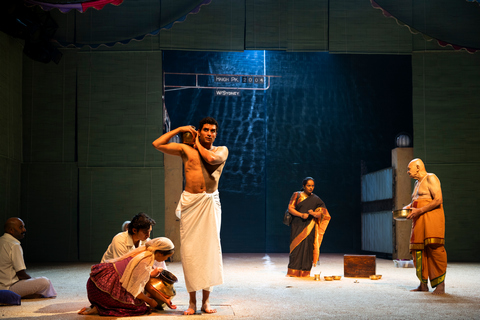
Ahilan Karunaharan, Kaivalya Suvarna, Abbie-Lee Lewis, Shiv Palekar, Nadie Kammallaweera and Gandhi MacIntyre in a scene from the Belvoir St Theatre and Kurinji co-production of S. Shakthidharan’s “Counting and Cracking” at NYU Skirball (Photo credit: Pia Johnson)
Every so often, a playwright writes an epic multigenerational play about a family that is also a history of his country. S. Shakthidharan’s powerful Counting and Cracking is just such a play. Lasting three and a half hours with two intermissions, this is a play that beautifully covers the lives of a Sri Lankan-Australian family stretching from 1954 Columbo, Ceylon (the name for Sri Lanka before 1972) to 2004 Sydney, Australia. It uses 16 actors and three onstage musicians in a co-production between Australia’s Belvoir St Theatre and Kurinji. It has taken both The Public Theater and NYU Skirball to bring this Australian masterpiece to New York City. It will also introduce many New Yorkers to the civil war that upended Ceylon/Sri Lanka for over several decades and divided many friends and families. Finally, the play is a plea for democracy over fascism, a timely reminder that one must stand up for one’s beliefs.
Aside from covering 50 years, the play is also presented in the three languages spoken in Sri Lanka: English and two languages native to the country, Sinhala spoken by the majority and Tamil spoken by the minority. Everything is always translated by actors who are not in scenes (rather than supertitles) but this is partly responsible for the extended running time as we learn a great deal of the first half of the play in two languages, sometimes in three. Under Eamon Flack’s lucid, clean and uncomplicated direction with an assist by the author, the time periods and locations are announced by metal markers hung high up over the stage left side of the minimalist set as though they were street signs. The play has an autobiographical component as much of what happens is from the author’s family history, a saga he did not know until he began researching the play.
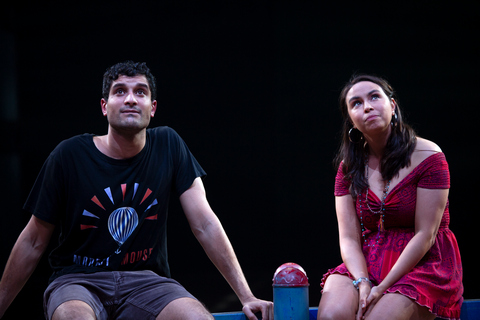
Shiv Palekar and Abbie-Lee Lewis in a scene from the Belvoir St Theatre and Kurinji co-production of S. Shakthidharan’s “Counting and Cracking” at NYU Skirball (Photo credit: Pia Johnson)
The epic story begins in Sydney, Australia in 2024 when the Sri Lankan Radha is burying the ashes of her mother with her 21-year-old son Siddhartha being told how to perform the correct rites by a priest. Having been born in Australia when his mother fled the civil war in Sri Lanka in 1983, he knows almost nothing of his heritage or of his family’s important part in the history of his ancestral country. He has a girlfriend and a life in Sydney separate from the troubled life of Sri Lanka. His mother has been silent on her life before moving to Australia. He then receives a phone call from Colombo, the legislative capital of Sri Lanka, which will change his life forever.
In the second act which takes place on the day his mother is born in Colombo we find that her parents live with her grandparents Apah and Aacha, her grandfather being the government’s Trade Minister, he is part of the Tamil minority. However, things are already beginning to come apart as there is a movement to make the official language Sinhala and outlaw both English (the official language when it was a British Crown Colony) and Tamil. We next jump ahead to Colombo in 1977. Apah, no longer in the majority party, has been arrested for protesting in parliament and has been brought home under arrest by government official Vinsanda, the father of Radha’s fiancé, the journalist Hasaanga, and Apah’s “personal friend and political opponent.” Radha breaks off her engagement to Hasaanga and proclaims her plan to marry the poor engineer Thirru who believes in the things that she has been taught to believe. He receives a message that his sister Swathi has joined the revolutionary Tigers, an underground Tamil group fighting for their rights in what is quickly evolving into a dictatorship.
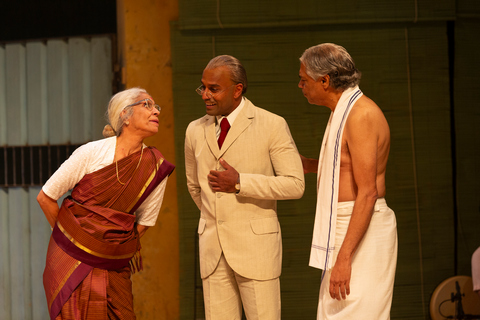
Sukania Venugopal, Dushan Philips and Prakash Belawadi in a scene from the Belvoir St Theatre and Kurinji co-production of S. Shakthidharan’s “Counting and Cracking” at NYU Skirball (Photo credit: Pia Johnson)
Act Three takes us to Colombo in 1983 as the political tension is rising. Radha, four months pregnant, still working on democratic measures, says goodbye to her recent husband Thirru. The elderly Apah, still a force in the government on the side of the Tamils, begins to get urgent phone calls from all around the city as riots against the Tamils break out in many places with the police standing by and doing nothing. In what ultimately becomes a pogrom against the Tamils, her husband Thirru is arrested and disappears, and she and we assume he has been killed in the unrest. Radha is urged to flee the country on a visa to Australia. In the final scene set in 2004, with Radha now 48 and Sid, 21, we finally find out how all this played out for the family. The ending is both poignant and shocking, bringing the story to a close.
Aside from the use of Dale Ferguson’s minimalist set which includes only one item to set each scene, a bench, a chair, a seesaw, etc., and a set of gates in the back to differentiate between indoor and outdoor scenes, Flack’s direction uses all types of theater: various unassigned actors narrate or translate for us, the props are held up by actors (for example, a telephone, a door intercom, etc.) rather than attached to scenery in Act One and in Act Three the urgent phone calls to Apah are staged all over the theater as if in different places. Actors on the sidelines to the main stage create sound effects using simple everyday items. The bland stage picture is filled out by the colorful costumes of Ferguson in which many of the women wear vibrant red fabrics. Damien Cooper’s lighting for the many scene changes helps create the various locales both in Sydney and Colombo. The original music by Stefan Gregory is played live by Kranthi Kiran Mudigonda, Venkhatesh Sritharan and Janakan Suthanthiraraj who sit on a platform on stage right of the main stage throughout the evening.
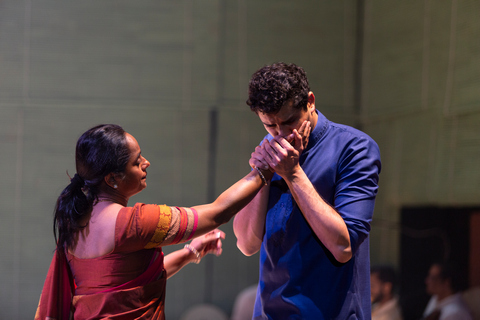
Nadie Kammallaweera and Shiv Palekar in a scene from the Belvoir St Theatre and Kurinji co-production of S. Shakthidharan’s “Counting and Cracking” at NYU Skirball (Photo credit: Pia Johnson)
In addition to Flack’s astute staging, his work with the actors has been superlative considering many of the 16 actors reappear in crowd scenes as other characters. Shiv Palekar as the 21-year-old protagonist Siddhartha is both sardonic and awkward, suggesting a young man on the verge of adulthood. As his mother, the older Radha, Nadie Kammallaweera is an assertive, no-nonsense woman who knows exactly how she wants everything ordered, some of which is her upbringing and some her life experience. As her great grandfather Apah, Prakash Belawadi is a model of good manners and diplomacy, and a wealth of wisdom. Sukania Venugopal as her grandmother Aacha is commanding and imposing, a queen in her own house.
As the young Radha living in Colombo, Radhika Mudaliyar is feisty and quick to fight for her beliefs. As the man she chooses to marry, Kaivalya Suvarna’s low caste Thirru is modest and sympathetic while Radha’s family seems to be to the manner born. As the opposition spokesperson, Dushan Philips as Vinsanda is frighteningly authoritative while Ahilan Karunaharan as the Indian arms dealer Sunil is sinister and menacing. As Vinasanda’s son Hasa, Sukhbir Singh Walia (Sunny) is efficient, low-key and energetic. Abbie-lee Lewis as Sid’s curious girlfriend Lily has a family and a history that she only begins to narrate. Rodney Afif offers comic relief as the Turkish air conditioner repairman who is falling for the unavailable Radha.
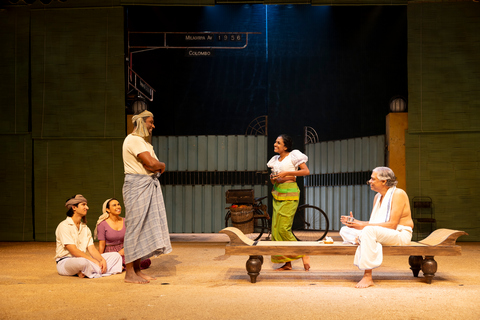
Kaivalya Suvarna, Abbie-lee Lewis, Rajan Velu, Nipuni Sharada and Prakash Belawadi in a scene from the Belvoir St Theater and Kurinji co-production of S. Shakthidharan’s “Counting and Cracking” at NYU Skirball (Photo credit: Pia Johnson)
While Counting and Cracking is an unforgettable epic of a family and a country, it is also a study of the fight for democracy and the lengths people will go to fight for their beliefs. The title comes from Apah’s definition of democracy: “Democracy means the counting of heads, within certain limits, and the cracking of heads beyond those limits.” The play could not be more timely as we go into the last weeks of this fraught election campaign. Counting and Cracking will be one of those evenings in the theater that will become legendary both for its storytelling, its staging and its message.
Counting and Cracking (September 6 – 22, 2024)
Belvoir St Theatre and Kurinji co-production
Presented by The Public Theater in partnership with NYU Skirball
NYU Skirball, 566 LaGuardia Place, south of Washington Square South, in Manhattan
Running time: three hours and 30 minutes including two intermissions






Leave a comment